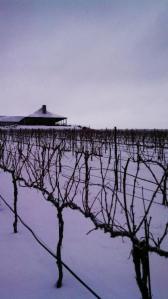Chaumette January News: Letter from Hank

Happy New Year, Everyone!
Last month in this column, I talked about dormancy. The news this month is low temperatures. At Chaumette on the coldest day, I saw minus 8 degrees out my window, and I was sure glad that I was not growing vines from the vitis vinifera family. You will remember that vitis vinifera includes all of our European friends like Chardonnay, Cabernet Sauvignon, Merlot, Pinot Noirand so forth. What we grow are interspecific hybrids and one native grape, Norton. The hybrid grapes have been bred to be resistant to cold temperatures as well as being slow to wake up from dormancy. In preparation for this month’s newsletter, I referenced my viticulture textbooks to be sure that I was correct on certain temperature levels.

Vitis vinifera grapes start sustaining damage below 10 degrees Fahrenheit, and the damage is progressive all the way to minus 8 degrees Fahrenheit for most vinifera varieties. At 8 degrees below zero, not only is there bud death but also cane death and also trunk death. It is likely that vitis vinifera grapes will be killed to the ground line or snow line if there is snow at minus 8 or below.
I have heard similar temperature occurrences in years past in Missouri that have resulted in losing entire vineyards of Cabernet Sauvignon. When I describe the damage from low temperature episodes, I’m referring to the part of the vine that is above ground. These temperatures do not kill the entire plant. The root system remains viable and in the spring will send up a new sucker to become a new plant. The problem is it will then take three years to get the first small crop. In essence, the vineyard has to start over.
The grapes that we grow at Chaumette are much more able to withstand cold temperatures, but we do expect some damage. The first test we will perform next week will be to remove single buds from various parts of different vineyard blocks. Using a razor blade we will slice these buds in half. Grapevine buds are called compound buds, because they contain three separate primordia. Within the compound bud, there is a primary bud primordia, a secondary bud primordia, and a tertiary bud primordia. In the spring in most cases only one of the three buds will swell and produce a shoot. The three potential shoots will emerge in order of primary, secondary, and then the tertiary. So, if the first primordia emerges and a deer bites it off, the secondary bud of the compound bud then emerges as a replacement; if there is a late frost and that shoot is killed, the tertiary bud will then emerge with a third shoot. Every bud has three chances.

Back to our dissection. The primary bud primordia is about double the size of the secondary which is larger than the tertiary. We will examine a cross section of all three of the compound buds with a magnifying glass to determine whether or not they are viable. If all three are green and healthy looking, we know that we have no damage, and the primary bud will emerge in the spring. On the other hand, if we see a brown primary bud and a green secondary bud, we can count on a much smaller harvest, because the secondary is considerably less fruitful; in fact it might produce only 50% of what would be produced by the primary bud.
So keep your fingers crossed as we do our dissections. We want to see a minimal loss of primary buds. I would like to say no loss of primary buds, but I think that is unlikely, since we did experience minus 8 degrees for our hybrid plants.

In other news, we are delighted to open Chef Adam’s “pop-up” restaurant on Saturdays this February and March in our Barrel Room, Lambay’s India at Chaumette! For years, I have enjoyed Adam’s Indian featured dish on our Grapevine grill menus, and what’s more is that it pairs so well with many of our wines, such as our aromatic off-dry Vignoles, our semi-dry Chardonel and our fruit-forward red blend, Mosaic! We hope you will join us on a Saturday evening for a delicious Indian dinner!
Cheers!



+ There are no comments
Add yours